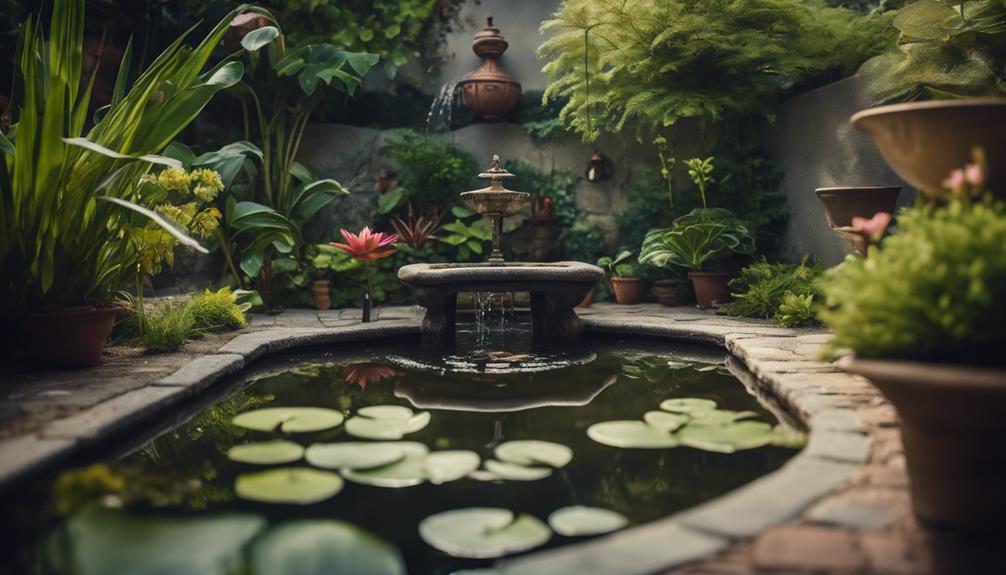Starting with a small water garden design allows you to create a peaceful oasis without breaking the bank or dedicating a large space. You'll reap the benefits of a water garden – attracting local wildlife, regulating temperature, and enjoying a serene atmosphere – with minimal maintenance requirements. Small water gardens are budget-friendly, easy to care for, and can thrive in small spaces like balconies or patios. By choosing the right container, selecting plants with contrasting shapes and colors, and arranging them thoughtfully, you'll create a visually appealing composition. Now, take the next step and discover how to bring your small water garden to life.
Table of Contents
Key Takeaways
- A small water garden design is a low-maintenance and budget-friendly way to create a peaceful ambiance in a small outdoor space.
- Small water gardens are easy to care for, and their compact size makes them perfect for balconies, patios, or small yards.
- Starting small allows you to test the waters, gain experience, and refine your design before scaling up to a larger water garden.
- A small water garden design is a cost-effective way to attract local wildlife, such as birds and butterflies, to your outdoor space.
- With a small water garden, you can enjoy the benefits of a water feature without the overwhelming maintenance requirements of a larger garden.
Benefits of Small Water Gardens
By incorporating a small water garden into your outdoor space, you can experience the tranquil ambiance and numerous benefits that come with it, including flexibility in design and minimal maintenance requirements.
With at least six hours of direct sunlight, your small water garden will thrive, and you'll appreciate the low upkeep. Most water plants are hardy and can be easily rearranged in the container, giving you the freedom to experiment with different layouts.
A small water garden can also inspire larger designs, and its compact size makes it perfect for small gardens. Imagine adding sparkle to your outdoor space with a 5-gallon nursery pot, which can be as small as 18 inches deep.
The benefits don't stop there – your small water garden will attract various types of wildlife, regulate temperature through evaporation, and create a peaceful ambiance that makes you feel connected to nature.
With a small water garden, you can enjoy the serenity and beauty of water features without breaking the bank or sacrificing too much space.
Choosing the Right Container
Selecting the right container is the next step in bringing your small water garden to life. You'll want a container that holds water, like a plastic wine barrel planter or a ceramic pot with a plugged drainage hole.
Certify it's at least 12-18 inches deep to accommodate water plants, and opt for one with a wide mouth for easy maintenance. Durable materials like plastic or ceramic are recommended, and don't forget to add drainage holes to prevent waterlogged soil.
Consider a self-watering container to reduce maintenance, or one with a liner to prevent toxins from leaching into the water. Avoid metal containers that can heat the water, and instead choose materials that won't compromise the health of your plants and fish.
A plastic pot, for instance, is a great option. When selecting a container, think about the overall aesthetic you want to achieve in your small water garden. Remember, the right container will set the tone for your entire design, so take your time and choose wisely.
With the right container, you'll be one step closer to creating a peaceful retreat that brings you joy and serenity.
Selecting and Arranging Plants
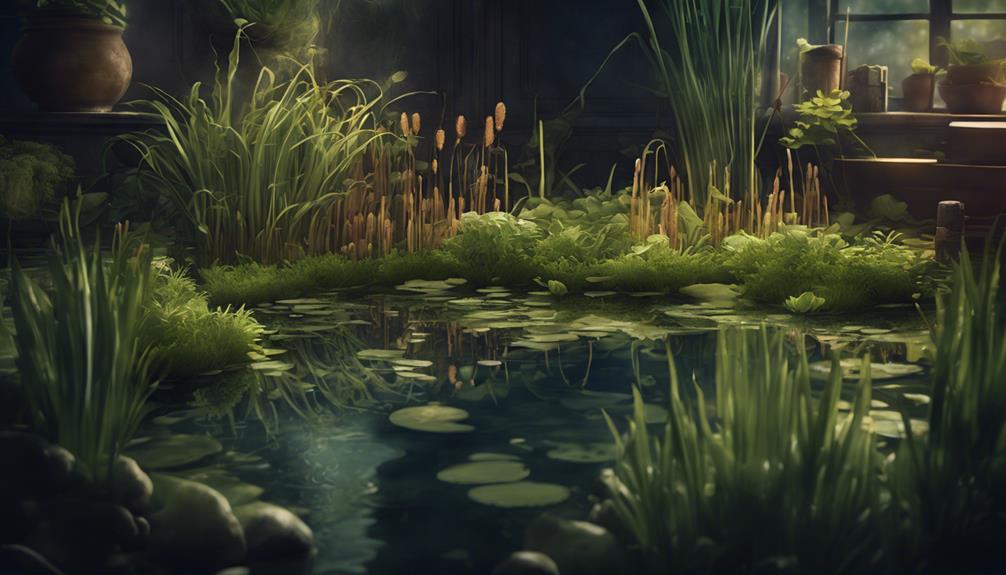
As you select plants for your small water garden, remember that combining plants with contrasting shapes, colors, and sizes will create a visually appealing composition.
You'll want to thoughtfully arrange these plants to add depth and interest, such as pairing tall, slender plants with broad-leaved ones.
Plant Combinations Matter
When designing a small water garden, you'll want to carefully select and arrange plants to create a visually stunning composition that draws the eye and engages the senses.
By combining plants with contrasting shapes, colors, and sizes, you'll create a harmonious and proportionate arrangement that showcases each plant's unique features.
For example, pair tall, slender plants like yellow flag iris and sweet flag with broad-leaved plants like taro to add depth and interest to the arrangement.
Using only two or three plants can create a more harmonious composition, allowing each plant to shine without visual clutter.
Marginal plants, typically placed along the edges of a water garden, can be used in small containers to create a sense of layers and texture.
Consider cascading plants that spill over the edges, adding movement and visual interest to your water garden.
Marginal Plant Placement
You'll achieve a more dynamic marginal plant placement by carefully selecting and arranging plants in a way that creates a layered, textured look, drawing the eye to specific areas of your small water garden. When choosing plants, consider pairing tall, slender varieties like yellow flag iris and sweet flag with broad-leaved plants like taro to create a harmonious composition.
To visually showcase your plants, use the following design principles:
| Design Principle | Example |
|---|---|
| Tall plants towards the back | Yellow flag iris |
| Shorter plants towards the front | Taro |
| Varying heights with bricks or pots | Empty pots |
| Limited plant selection for harmony | 2-3 plants |
| Mixing textures and forms | Sweet flag and taro |
Easy Maintenance and Care
Properly maintaining your small water garden requires regular monitoring of water levels, as neglecting this essential task can lead to stagnation and an overgrowth of algae.
You'll want to check the water level daily, especially during hot weather, to guarantee it doesn't drop below the pump's intake. If you notice the water level dropping, you can top it up with fresh water.
It's also essential to change the water regularly to maintain water quality. A good rule of thumb is to change about 10-20% of the water every week. This will help prevent the buildup of toxins and keep your small pond healthy.
Easy maintenance and care are pivotal to enjoying your water garden. By staying on top of water levels and changing the water regularly, you'll be able to relax and appreciate the beauty of your small water garden.
With a well-maintained pond, you'll be able to enjoy the sights and sounds of nature, right in your own backyard.
Controlling Mosquitoes and Algae
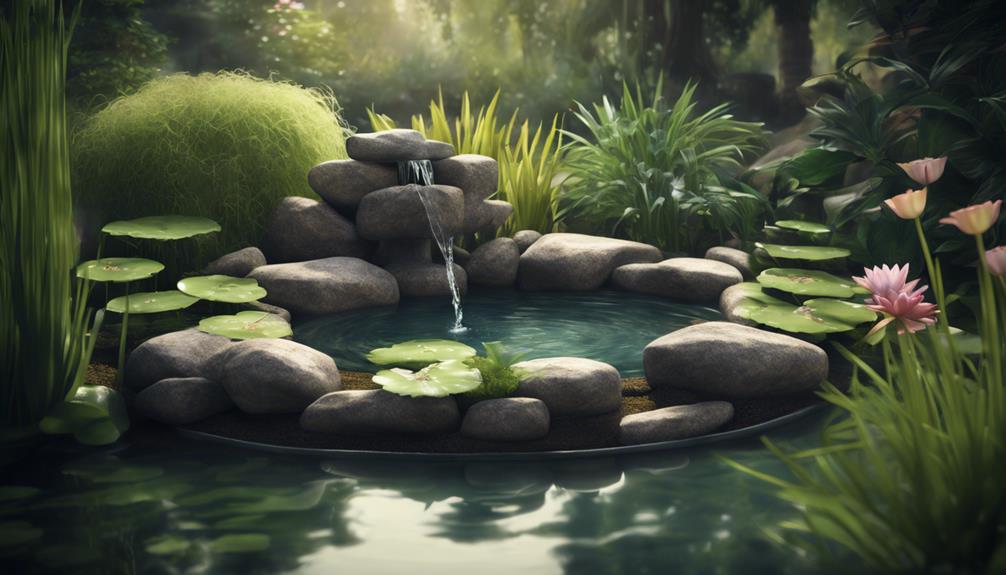
By incorporating a few simple strategies into your small water garden's maintenance routine, you can effectively control mosquitoes and algae, two common issues that can detract from its beauty and tranquility.
To tackle mosquitoes, consider adding mosquitofish to your water garden, as they naturally feed on mosquito larvae. Alternatively, you can use specially formulated products that target mosquito larvae.
Regular water changes are also vital, as they remove excess nutrients that fuel algae growth.
To further reduce algae growth, incorporate oxygenating plants like cabomba or anacharis into your small water garden. These plants absorb excess nutrients, depriving algae of the fuel they need to thrive.
Providing shade for your water garden can also help minimize algae growth, as algae require sunlight to grow.
Winterizing Your Water Garden
As you prepare your small water garden for winter, you'll need to take steps to protect your plants from frost and freezing temperatures.
You can bring sensitive plants indoors, using care to avoid shocking them with changes in light and temperature.
Protecting Plants From Frost
When winterizing your water garden, you'll need to take steps to protect your plants from frost, which can be achieved through a combination of clever planning and clever storage solutions.
For instance, you can bring your water lilies and other plants indoors to use as houseplants or keep them in an aquarium during the winter months. This way, you can guarantee their safety from frost and freezing temperatures.
Alternatively, if you have hardy plants, you can leave them in their container and use birdbath-type heaters to prevent the water from freezing in severe winters.
Additionally, you can bring your plants to a cool basement or garage to overwinter, and then divide them in the spring to start a new water garden.
Bring Plants Indoors Safely
To bring your water plants indoors safely, choose a spot with bright, indirect light and consistent temperatures between 50°F and 70°F (10°C and 21°C), as most aquatic plants require these conditions to thrive during the winter months. This will guarantee your small water garden's potted plants continue to flourish while protected from freezing temperatures.
Most aquatic plants need bright, indirect light to photosynthesize and stay healthy.
Avoid placing your plants near heating vents or drafty windows to prevent temperature fluctuations.
Regularly check the water level and quality to prevent stagnation and maintain a healthy environment for your plants.
Divide and Repot Plants
You're now ready to divide and repot your water plants, a process that not only revitalizes your design but also guarantees the health and vigor of your plants during the winter months.
As you prepare your water garden for the cold season, remember that most plants can be brought indoors or protected from freezing temperatures to safeguard their survival.
When dividing and repotting, gently remove the plants from their containers, taking care not to damage their roots. Trim and prune as necessary to promote healthy growth, and replant them in fresh potting mix.
This process allows your plants to grow anew, invigorating your water garden design for the next growing season. By dividing and repotting, you're giving your plants a chance to thrive, and your water garden will thank you come spring.
As you tend to your plants, envision the vibrant blooms and lush foliage that will soon return to your outdoor oasis, and take pride in knowing you've taken the necessary steps to safeguard their success.
Expanding Your Water Garden
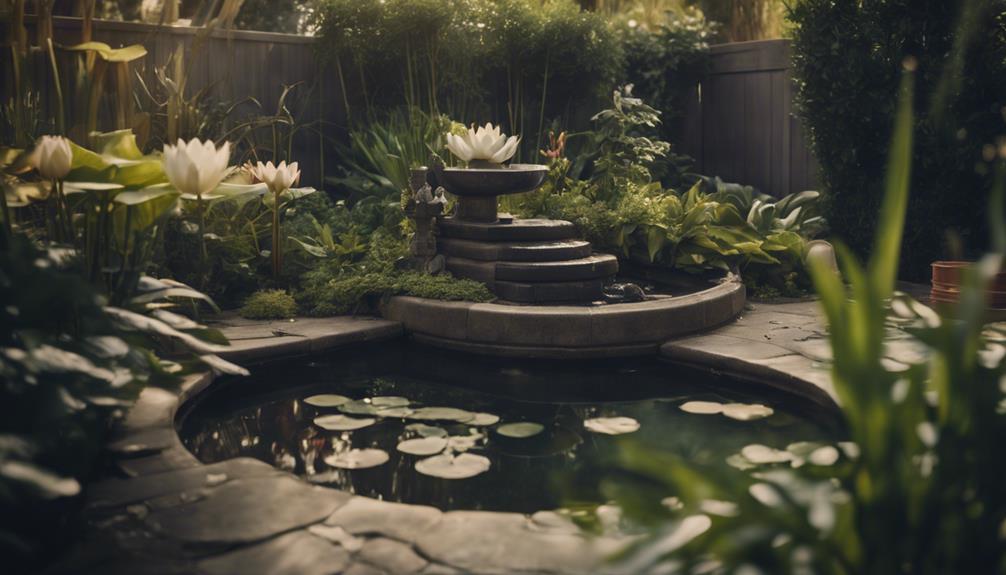
Take your water garden to the next level by incorporating new features and elements that amplify its visual appeal and create a unique, personalized oasis. You've mastered the basics of small water garden design, and now it's time to expand and experiment.
Add water features: Incorporate fountains or ponds to create a visually stunning display. Consider using a lined pond for a cleaner and easier-to-maintain garden.
Divide and repot: Divide large plants in the spring to start a new water garden or add to an existing one. This is a great way to share plants with friends or create a new design.
Experiment with plants and containers: Try out different plants and containers to create a one-of-a-kind water garden design. Don't be afraid to get creative and make it your own!
Locating Your Water Garden
When locating your small water garden, you'll want to ponder how it will interact with its surroundings.
Will you blend it seamlessly into the landscape, or use it as an accent or focal point to draw the eye?
Blend With Landscape
Position your water garden to create a seamless shift between the pond and surrounding landscape, ensuring the water's edge appears to blend organically with the adjacent terrain. A well-integrated water feature will create a sense of harmony and balance in your outdoor space.
When designing your small water garden, consider the following tips to blend with the landscape:
Choose a location with a natural slope. This will help the water's edge merge with the surrounding terrain, creating a sense of continuity.
Select plants that complement the surrounding landscape. Use plants with similar textures, colors, and growth habits to create a cohesive look.
Consider the sun's path. Place your water garden in a sunny spot to create a warm and inviting atmosphere.
Accent or Focal Point
Decide where to locate your small water garden to create a striking accent or focal point in your outdoor space, drawing the eye to a specific area or feature.
This strategic placement will enhance the visual appeal of your yard, balcony, or patio. Consider placing your water garden near a seating area or a pathway to create a sense of journey and discovery.
Alternatively, you can position it as a standalone accent in a corner or against a wall, adding depth and visual interest to the space.
In a balcony garden, a small water garden can become a beautiful focal point, drawing the eye upwards and creating a sense of serenity.
When choosing a location, think about the direction of sunlight and wind patterns to guarantee your water garden thrives.
Also, consider the style and theme of your outdoor space, and select a water garden design that complements it.
Near Seating Areas
By situating your small water garden near a seating area, you'll create a mesmerizing visual anchor that invites relaxation and contemplation. This strategic placement allows you to fully immerse yourself in the calming atmosphere of your water feature while lounging in comfort. As you sit nearby, the gentle ripples and soothing sounds of the water will transport you to a state of tranquility.
Enhanced ambiance: The proximity of your seating area to the water garden amplifies the sensory experience, enveloping you in a cocoon of serenity.
Increased interaction: By placing seating areas near your small water garden, you're more likely to engage with the feature, whether it's feeding fish, observing aquatic plants, or simply enjoying the view.
Improved functionality: This thoughtful design decision allows you to seamlessly shift between relaxation and entertainment, effortlessly hosting gatherings or quiet moments of reflection.
Creating a Visually Appealing Design
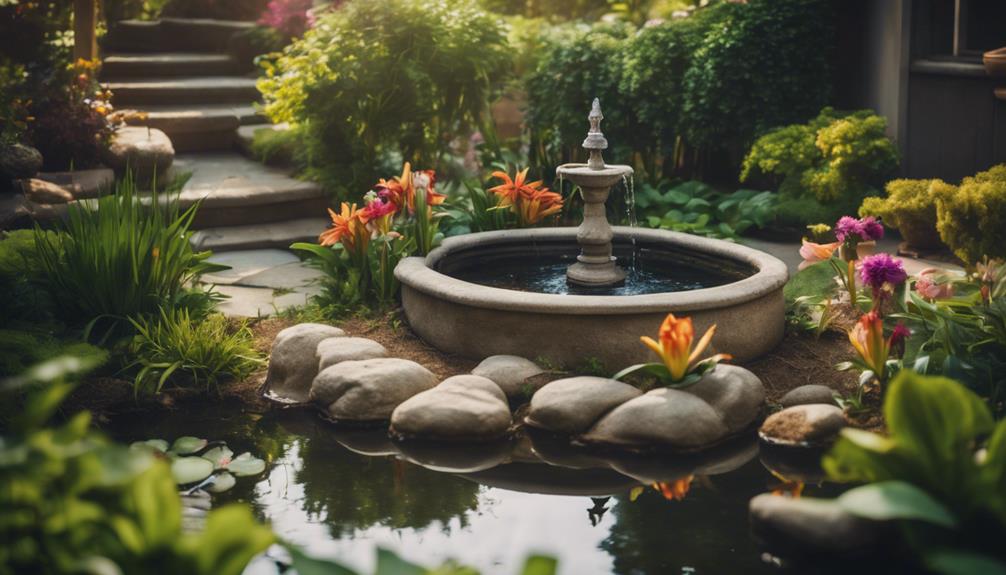
When designing a small water garden, you can craft a visually appealing composition by carefully selecting and arranging plants with contrasting shapes, colors, and sizes.
This flexibility in design allows you to get creative with your plant choices. For instance, pair tall, slender plants like yellow flag iris and sweet flag with broad-leaved plants like taro to add depth and interest to your design.
Marginal plants, which thrive in shallow water, can be used in small containers and placed along the edges of your water garden to create a layered look.
Unusual plant combinations, such as pairing a water lily with a bog plant, can create exciting and unique designs in small water gardens.
Remember, the placement of plants in the container is vital to creating a visually appealing design. Typically, place taller plants towards the back and shorter plants towards the front.
Adding Fish and Other Elements
As you've carefully curated your plant selection, now it's time to ponder adding life and movement to your small water garden with the introduction of fish and other elements that enhance its visual appeal and ecosystem balance.
Adding fish, such as small goldfish, can bring a new dimension to your water garden. Just remember to maintain a ratio of one inch of fish per gallon of water.
Water Maintenance: Change the water every 10-14 days to keep it clean and healthy for your fish. Regularly clean the container and plants to prevent debris buildup.
Circulation and Oxygenation: Add a small pump to improve water circulation and oxygenation. You can also add a filter to reduce maintenance and keep the water clean.
Visual Interest: Add decorations like rocks or ornaments to create visual interest. Consider a trellis or other support for climbing plants like water mint.
Tips for Beginners and Experts
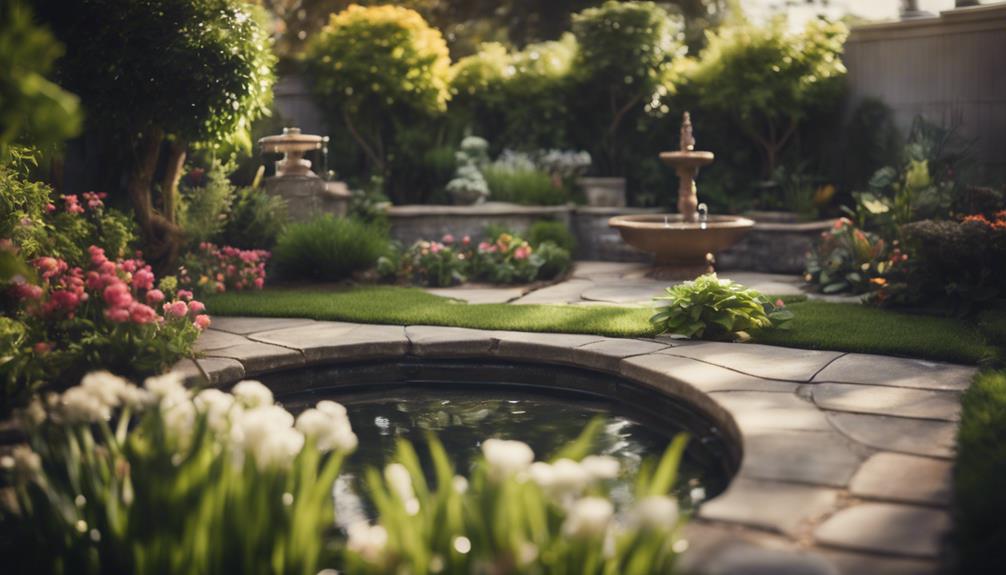
Designing a small water garden that thrives requires attention to detail, and whether you're a beginner or an expert, incorporating a few key strategies will help you create a visually stunning and balanced ecosystem.
When selecting plants, choose a mix of heights, including marginals, water lilies, and floaters, to create a visually appealing display. Consider using small pots to add water mint or other plants that thrive in containers.
Remember to place your water garden in a sunny spot with at least six hours of direct sunlight, as most aquatic plants thrive in such conditions. Use a container that's at least 12-18 inches deep with drainage holes to prevent waterlogged soil.
By incorporating these tips, you'll be well on your way to creating a thriving small water garden. Additionally, consider adding a few small fish, like goldfish, to help control mosquito populations and add to the overall ecosystem.
With these strategies, you'll be able to create a beautiful and balanced water garden that brings you joy and serenity.
Common Mistakes to Avoid
You'll want to steer clear of common mistakes that can quickly turn your small water garden into a stagnant, algae-ridden mess. A well-designed water garden is a tranquil oasis, but a poorly planned one can be an eyesore.
Inadequate Filtration: Failing to install a proper filtration system can lead to an overgrowth of algae, making your water garden look murky and uninviting.
Overcrowding: Planting too many aquatic plants, such as water hyacinth and water lettuce, in a small space can cause them to choke each other out, reducing oxygen levels and creating an environment conducive to algae growth.
Improper Container Selection: Using a whiskey barrel or other container that's too small or shallow can lead to water quality issues and make it difficult to maintain a healthy ecosystem.
Frequently Asked Questions
What Is the Purpose of a Water Garden?
You create a water garden to cultivate an aesthetic appeal, support ecological importance, and evoke visual serenity, ultimately providing a tranquil atmosphere that promotes relaxation, biodiversity, and a deeper connection with nature.
What Are the Benefits of a Watered Garden?
You'll reap numerous benefits from a watered garden, including water conservation through efficient irrigation systems, enhanced aesthetic appeal with vibrant plants and decorative features, and serenity creation through soothing sounds and visual tranquility.
How Do You Start a Small Water Garden?
You create a small water garden by designing a visually appealing layout, selecting plants like cannas and water lilies, and incorporating water features like a fountain or spout, ensuring a balanced and thriving ecosystem.
How Do You Start an Underwater Garden?
You'll create an underwater garden by selecting aquatic plants, water features, and garden decorations that thrive in a controlled environment, carefully considering container depth, drainage, and circulation to showcase your unique, visually stunning aquatic oasis.
Conclusion
As you step back to admire your small water garden, the gentle ripples and soft whispers of the water contrast sharply with the chaotic world beyond.
Amidst the serenity, vibrant plants sway, and fish dart, their colors popping against the calm backdrop.
Your carefully crafted oasis is a haven, where the soothing sounds and sights wash away stress, leaving you refreshed and renewed.

